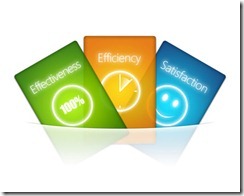User Experience Phase 2: Implementation
 In our first article, we walked through the process of auditing and evaluating the User Experience of your website. In this article, we’ll map out an Implementation Plan to tackle the items that you identified in Step 6 as:
In our first article, we walked through the process of auditing and evaluating the User Experience of your website. In this article, we’ll map out an Implementation Plan to tackle the items that you identified in Step 6 as:
- Easily and immediately actionable.
- Worth implementing but requiring additional resources or time to roll out.
The Easy Stuff
Get through all the “easily and immediately actionable” items and you’ll feel a great sense of accomplishment. These may take a day, a week or a month to complete. But now you’re ready to get down to some real work.
Let’s start with some implementation guidelines:
- Create a Style Guide for your website. Document how you hyphenate, capitalize, use bold face and italics, how much space you use between paragraphs, how to format charts, etc.
- If you have multiple changes that need to be made universally, the best approach is to create a checklist that you run through for each page in addition to the unique changes required. For example, you may want to make the Call to Action consistent on every page, or make your Company Name bold face in all places, or change references to the number of stores in all places from 10 to 25.
- For the purposes of tracking results, it’s useful to document exactly when changes are made on your site so that you can gauge the impact they have on your site statistics. In fact, you may find it helpful to maintain a detailed Change Log to document changes as they are made.
- If you’re making radical changes, it’s best to do all the work on “shadow” pages or a beta site and testing it before replacing the production pages. In some CMS applications, this may be difficult to do, so an alternative is to copy and paste all the HTML code into a Word document before making any changes. If you run into a problem, you can restore the entire page HTML content and start over again.
- Go one page at a time. Get each one right before you move on to the next.
- For any page with extensive changes, we recommend printing it out and marking it up first. Make all the changes at once. Then use a highlighter on the print out to proof your changes. It’s old school, but it works.
- If you have too much to fix than can be accomplished in one sitting, break it up into logical subsets. Ideally, you want to make all the changes in a single functional section at the same time. This will help minimize any discontinuity a visitor may experience if they use your site before you have completed all the changes.
The Heavy Lifting
Now it’s time to dig into the second category: “Worth implementing but requiring additional resources or time.” Many things may fall under this category. We’ll talk about a few of them here.
- Shopping Cart Optimization
For ecommerce sites, we suggested that you walk through the entire sales funnel. What did you learn from this? Are there features inherent within your shopping cart software that you’re effectively utilizing? Have you recently visited a competitor’s shopping cart? What are they doing better that you can put to work on your own site? This can be a daunting project but may deliver huge payoffs. Spend the time you need to do this right. - Reducing Page Load Times.
Are your pages taking a long time to load? Test your page load times using a free tool like Pingdom or Web Page Analyzer. Follow some of the suggestions these sites offer to improve your speed. Then see what insights Google Webmaster Tools can offer. Call your webhosting provider to get their recommendations on how to improve your speed. Applied Innovations’ team can offer invaluable consultation about how your site’s performance can be improved. - Navigation Changes & Improvements
Did you decide that there was a major navigation challenge with your site? Do you need to add a Search feature? Is continuity a problem? Is the User Journey missing something? Now is the time to dig into these. - Generate Supporting Content
Generate additional content that will help differentiate, clarify, educate and compel your audience. Hire professionals, if necessary. - Redesign
You may have decided that areas of your site need the benefit of a professional designer. Be sure that whoever you hire is an experienced UX person. You need a site that’s not just pretty. It needs to work for you.
If you’re looking at some significant development or creative expenses, you may want to divide these projects into segments. Like any worthwhile development or investment, just start with small steps.
Continue on to the article in our User Experience Optimization series – Phase 3: Competitive Analysis.
